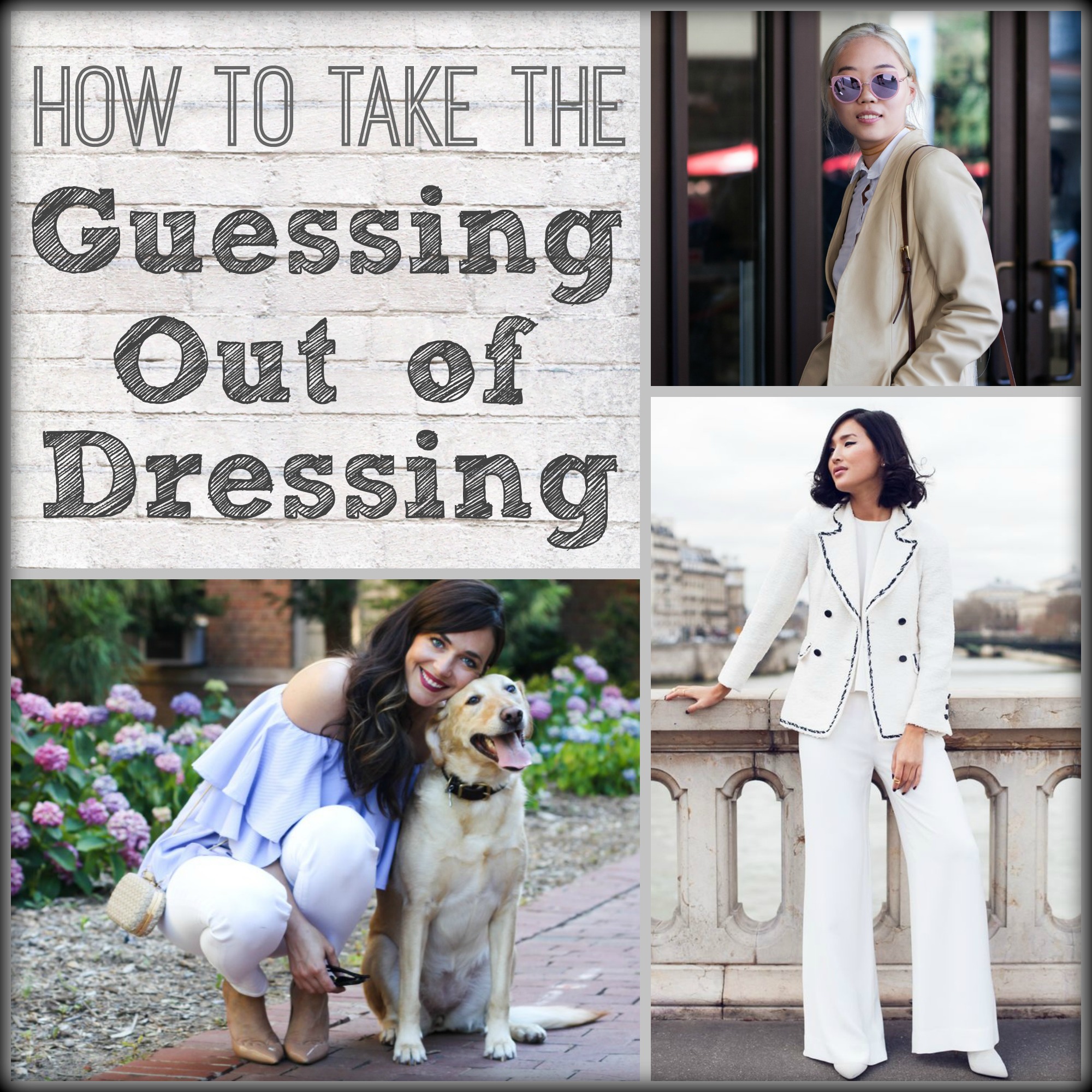
It’s happened to the best of us; showing up to an event only to discover you’ve not dressed appropriately. Not only is it embarrassing, it strikes a blow to your confidence, you feel conspicuous and it can give others the impression that you either don’t care or have not done your homework.
Most social and professional occasions have a dress code albeit some are unwritten. A dress code ensures that everyone is comfortable and suitably dressed for the occasion. Adhering to a dress code is also a form of etiquette and it shows respect to the host and puts everyone on equal footing.
It’s great when a dress code is written and explicitly provided since it saves guests from second-guessing. But sometimes, dress codes are implied. That’s when things can get a little tricky because you don’t want to appear over- or underdressed. If your host or if the invite doesn’t provide the dress code for the event you’re attending, there are key questions that can lead you to the right attire for the occasion.
The solution to your dressing dilemma can be found by asking yourself the following targeted questions:
What’s the occasion?
The occasion determines the type of dress expected. Any occasion associated with business or seriousness (i.e. funeral, court) requires a more conservative, buttoned-up manner of dressing. In this instance, stick to neutrals and tailored silhouettes. Never reveal too much skin. For an intimate dinner, however, this kind of attire will make you look stuffy and closed off. For an intimate dinner, you can be more fashion forward but try to still look more polished to show proper respects to the host. More often than not, the kind of occasion will dictate your look. Social events have more flexibility and opportunity to show off some fashion pizzazz while formal events have less room for trends and details.
Where will the event be held?
The event’s location helps determine the clothes you should wear. The fancier the venue, the fancier your clothes should be. The location of the venue should also influence your choice of footwear. If the venue is indoors, you should opt for heels or more formal flats. If the venue is outdoors like a garden wedding or a corporate event at a park, wedges and/or flats that are sensible are great choices. Outdoor events should also come prepared with a sunhat to keep off the sun or a cardigan/wrap against the chill.
When will the event be held?
The time of the event also gives you relevant clues about the level of dress expected. Your “Sunday Best” is appropriate for a wedding at a country club in the morning or early afternoon, but if the wedding takes place after 5 o’clock or later, cocktail or evening attire is entirely appropriate. Evening events have room for more glamorous details like embellishments, rich jewel tones, glitter, and statement jewelry. Daytime events call for breezy silhouettes, delicate and understated jewelry, and pastel colors.
Who will be there?
The more you know about the people who will be present at the event, the better you’ll know how to dress properly. Some things to consider about the people are their:
- Economic backgrounds
- Professions
- Ages
- Gender
- Relationships to one another
Also, consider:
- Are you acquainted with them?
- Do you want to impress them?
- Are they your allies/neutrals/competitors?
Asking these questions will help you in determining your look as well. The more intimate and personally connected you are to the people in attendance, the more leeway you have in expressing your personal style. If you are not well-acquainted with those in attendance, it is better to err on the side of caution and choose classic silhouettes and conservative looks.
What is my reason for attending the event?
Why are you going to this event? Is it to show support? Make a business contact? To be seen by certain people? Your motive for attending dictates the type of clothes you should wear. If you’re a speaker at a work event or if you have a specific role in a social event, you can be more creative and expressive with your ensemble. Since you have a special part, you can afford to be more distinctive. However, always keep appropriateness in mind. If your aim is to impress, make a statement with a key piece. Don’t be overstyled, rather choose a confident look that expresses power without overwhelming or drawing too much attention.
Casual or formal, social or serious, most likely you want to make a great impression and look your best. Looking your best shows respect for others and for yourself. Your clothes also serve as a silent ad campaign to influence and impress others with you.
How will I reach this goal?
Continuing from question #4, if you want to look your best, then your attire must be appropriate. Keep in mind you also want to dress similarly to those around you, because similarity visually invites rapport. Dressing appropriately opens doors—both business and personal—while inappropriate attire shuts those doors.
Who may I ask for advice on what level of dress is expected?
When in doubt, consult the host or hostess of the event. You might also seek out other attendees and ask what they are wearing so you can gauge your manner of dressing against theirs. If you are uneasy about reaching out to the host or other attendees, seek the advice of a professional image consultant. This is worth your time and resources if you are attending a particularly important event.
Here are a few examples of occasions where looking your best is important.
A Job Interview
Want the job? Then you’ve got to look capable, credible, and confident. Just as important is the fact you need to look like you fit within the organization’s image. Of course, different types of organization dress differently so ALWAYS do your homework by checking out any information on dress codes and sit somewhere close to their entry and watch what their employees wear. Then for your interview step it up a level to ensure you impress.
- Tailored classic-cut matching skirt or pant suit in a neutral color is your best bet for serious professions (law, finance).Mismatched suits are fine for other interviews.
- Contrasting colored top or blouse in a good quality fabric. Never underestimate the power of well-chosen color.
- Good quality, neutral or blended hosiery in 10-20 denier. Carry a spare pair for unexpected runs.
- Closed toe, medium heeled pump – polished and no scuffs.
- Understated medium size classic style earrings and only one non-essential accessory on the garment, i.e. a scarf or brooch.
- Classic handbag, tote or briefcase. Think structured shapes.
- Current, light, flattering make-up.
- Perfect grooming including the state of your clothes.
- Smile!
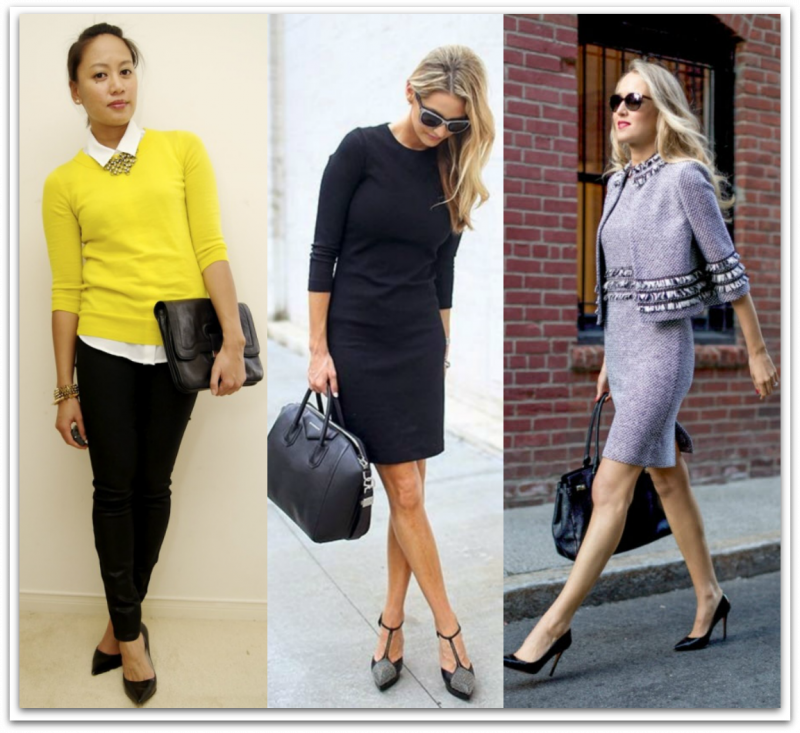
Source: Image 1, Image 2, Image 3
Giving A Presentation
When in front of a group, you’ve got to look confident while commanding attention and generating interest:
- Wear color to be visually interesting and noticeable.
- Create color contrast between your upper body layers or accessories. Keep the contrast at a medium level to maintain rapport with the greatest number of attendees.
- Cover your upper arms – it’s more professional and formal.
- Wear tailored garments in medium dark to dark colors if you wish to portray professionalism and authority. Brighter tailored outfits portray confidence and leadership.
- Skirt or pants suits are often better than dresses as they allow for a microphone to be attached to the waistband.
- Never wear a skirt shorter than just above the knee as the audience may be able to see up your skirt if you’re onstage.
- Wear quality shoes with a medium to medium-high heel.
- Apply your make-up applied slightly heavier than normal if you are likely to be lit by a spotlight so you don’t appear washed out.
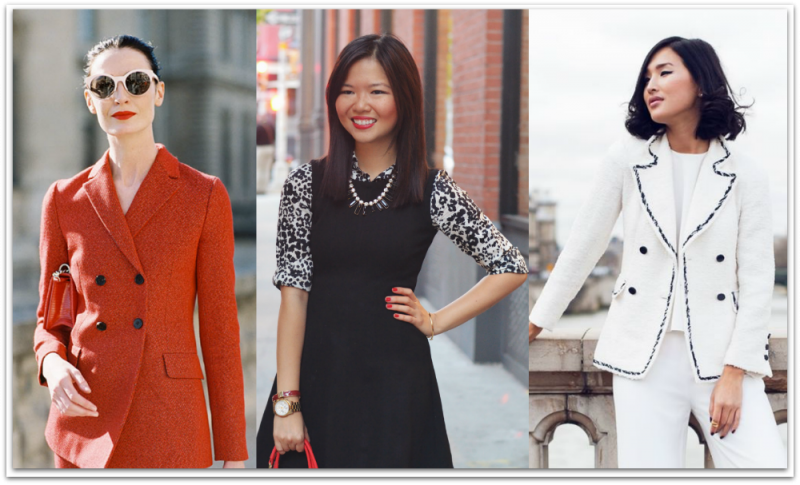
Source: Image 1, Image 2, Image 3
A Dinner Party
There are are so many types of dinner parties that it’s sometimes difficult to gauge the level of dress expected. Word of mouth invitations often indicate a relaxed level of dress while written invitations expect dressy attire. The more formal or expensive the stationery, the more formal the dress. Business-related dinners are also formal however limit necklines to those that just show cleavage and hemlines that allow you to bend without the threat of others seeing your lingerie.
- The classic little black dress worn with dressy accessories.
- A colorful long or short dress.
- A pair of grey or black pants with a beaded top or twin set.
- Dressy jewelry.
- Strappy and/or high heel shoes that are patent, fabric, or beaded.
- Evening make-up.
- Small dressy purse.
- Bare legs (if they look good) or sheer high quality hosiery.
- Limited skin exposure. A dinner party is not the same as a dinner date.
- Medium to high heels.
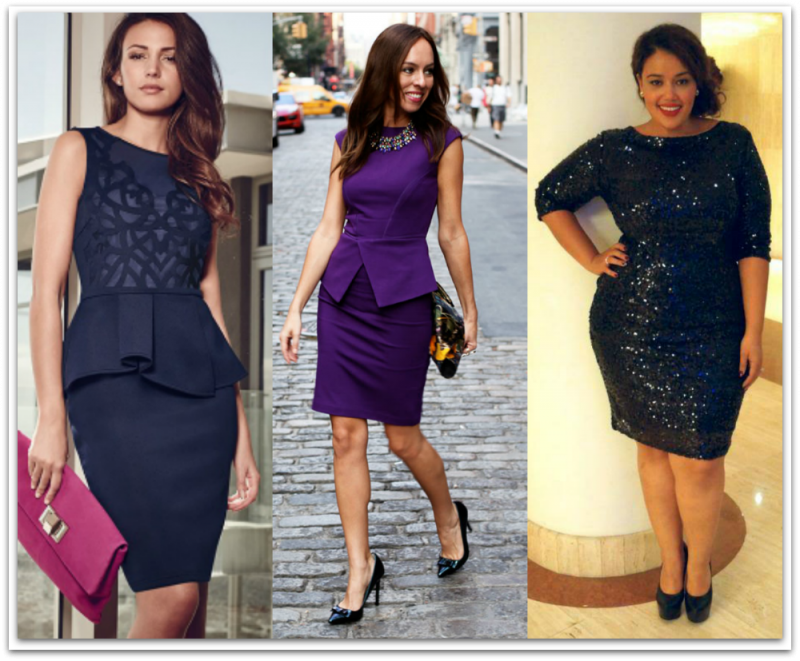
Source: Image 1, Image 2, Image 3.
A Funeral
Attending a funeral requires respect to the departed and allows to share your condolences with the family. Unless otherwise stated modesty and propriety rule.
- Clothes in subdued colors or black.
- Upper arms covered
- Non-revealing classic garments in conservative lengths.
- Modest necklines.
- Waterproof make-up.
- Understated accessories.
- Classic shoes, polished and in good repair.
- A handkerchief/tissues
- Dark glasses if you wish to hide your eyes. However, do remove them when inside.
If you enjoyed this week’s feature
please like it on Facebook or Instagram
or leave a comment/question below.
Thank you.
Ann Reinten AICI CIP
Author
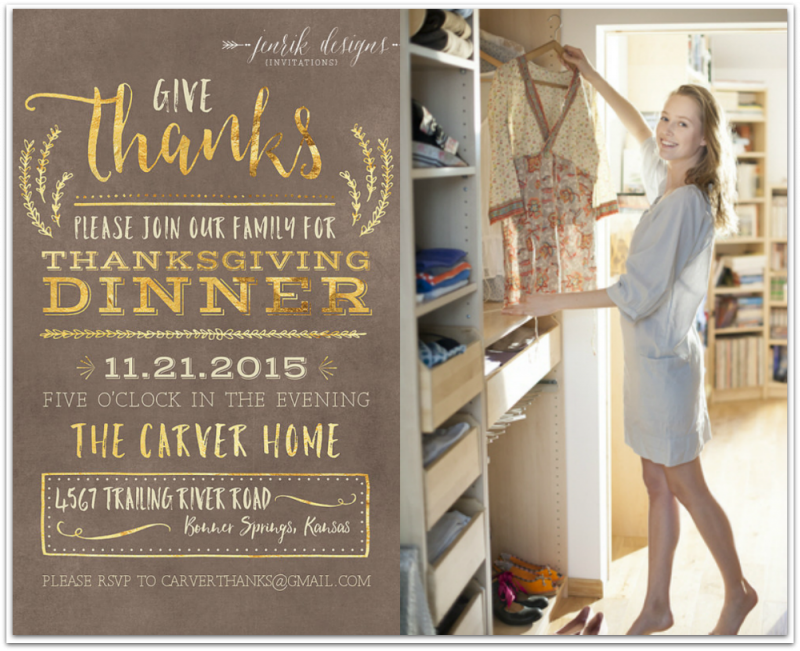
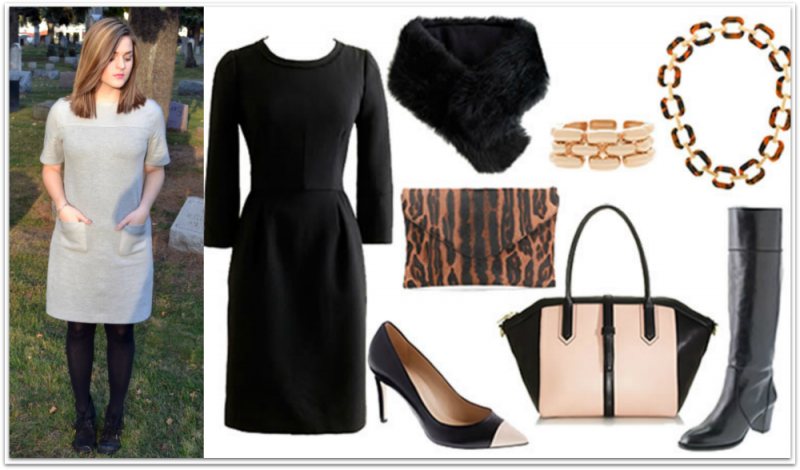

Recent Comments